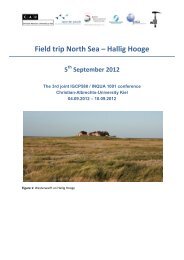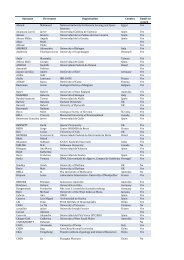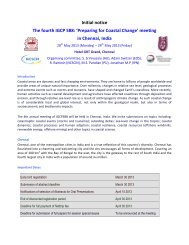Conference program and abstracts - Coastal-Change.Org
Conference program and abstracts - Coastal-Change.Org
Conference program and abstracts - Coastal-Change.Org
Create successful ePaper yourself
Turn your PDF publications into a flip-book with our unique Google optimized e-Paper software.
Millennial-scale records of North American Monsoon<br />
during the last glacial period from Mexican Deserts<br />
Priyadarsi Roy 1 , Jesus David Quiroz 2 , Marcela Charles 2 , Nayeli Lopez 3 ,<br />
Francisco Romero 1 <strong>and</strong> M.P. Jonathan 4 *<br />
1<br />
Instituto de Geologia, Universidad Nacional Autónoma de México, CP<br />
04510, México DF, México<br />
2<br />
Posgrado en Ciencias de la Tierra, Universidad Nacional Autónoma de<br />
México, CP 04510, México DF, México<br />
3<br />
USAI, Facultad de Quimica, Universidad Nacional Autónoma de México,<br />
CP 04510, México DF, México<br />
4<br />
Centro Interdisciplinario de Investigaciones y Estudios sobre Medio<br />
Ambiente y Desarrollo (CIIEMAD), Instituto Politécnico Nacional (IPN),<br />
Calle 30 de Junio de 1520, Barrio la Laguna Ticomán<br />
C.P. 07340, Del. Gustavo A. Madero, México, D.F., México.<br />
*Corresponding author: mpjonathan7@gmail.com<br />
ABSTRACT<br />
The Sonora <strong>and</strong> Chihuahua Deserts are spread over at least 8 different<br />
states present in the north-western <strong>and</strong> northern Mexico. The North<br />
American Monsoon (NAM) or Mexican Monsoon refers to the system that<br />
brings summer precipitation to this arid/ semi-arid part of Mexico <strong>and</strong><br />
southwestern USA. It contributes ca. 70-80% of total annual precipitation<br />
along the western slopes of the Sierra Madre Occidental (northern<br />
Mexico) <strong>and</strong> ca. 40-50% of total precipitation in Arizona <strong>and</strong> New Mexico<br />
(southwest USA). The multi-proxy data from lacustrine deposits located<br />
between 23° N <strong>and</strong> 31° N (paleolakes La Salada, Babicora <strong>and</strong> San<br />
Felipe) provide spatio-temporal <strong>and</strong> millennial-scale paleohydrological<br />
records over the last glacial period related to the dynamics of summer<br />
precipitation as well as westerly winter storms. The inverse relationship<br />
between the proxy records of runoff into lacustrine basins of northern<br />
Mexico <strong>and</strong> winter precipitation over the southwestern USA indicate the<br />
westerly winter storms had minimal influence south of 30°N <strong>and</strong> the<br />
paleohydrological changes are mainly summer precipitation controlled.<br />
The runoff records between 20 <strong>and</strong> 60 cal. kyr BP show a first order positive<br />
relationship with the summer insolation. On millennial-scale, the basins<br />
received more than average runoff during the warm interstadials <strong>and</strong><br />
vice versa. During the cold stadials, the westerly winds transported<br />
minimally chemically altered sediments from the dry watershed. Highresolution<br />
geochemical proxies suggest lower than average runoff <strong>and</strong><br />
higher than average lake water salinity during the Younger Dryas <strong>and</strong><br />
Heinrich events 1, 2 <strong>and</strong> 3. However the uncertainties associated with 14 C<br />
based age model, hiatus in sedimentation <strong>and</strong> extrapolation of the age<br />
model for the lower part of core could be the reason behind the lack of<br />
above mentioned observations during rest of the Heinrich events.<br />
The Fourth IGCP 588: PREPARING FOR COASTAL CHANGE 13





